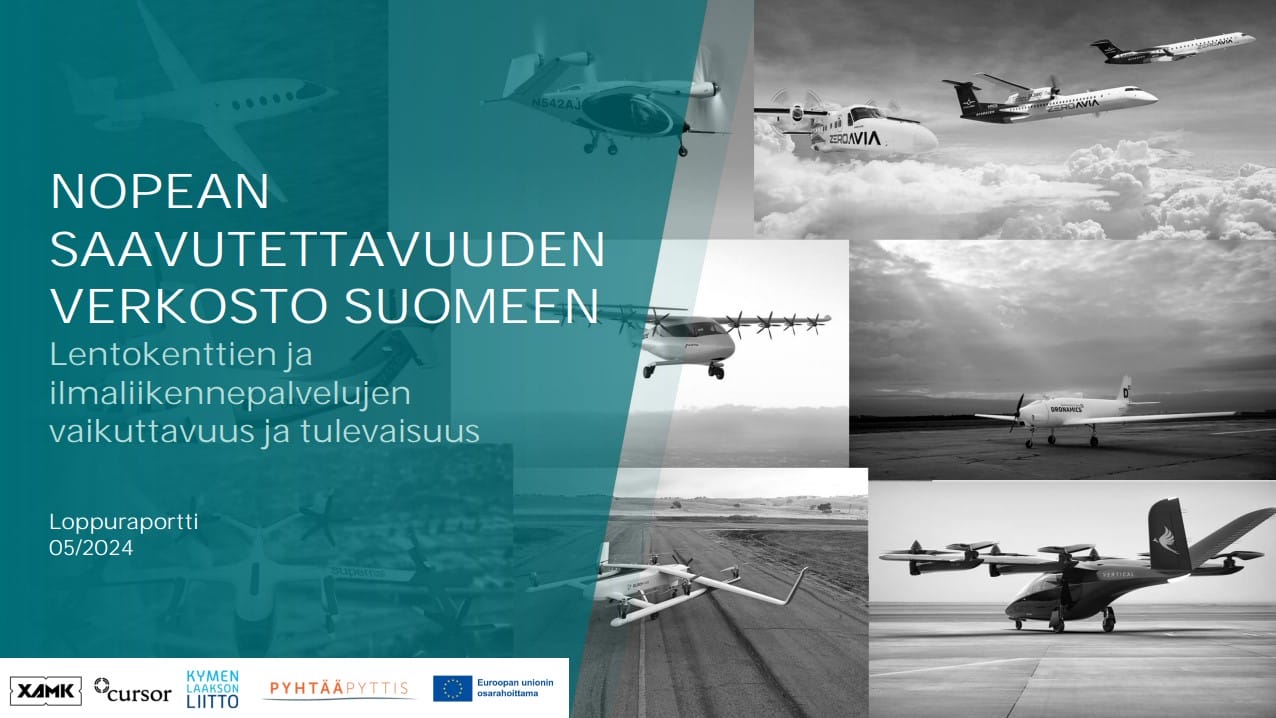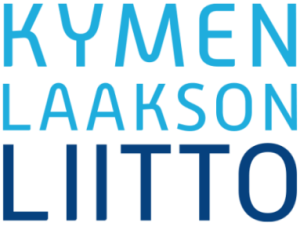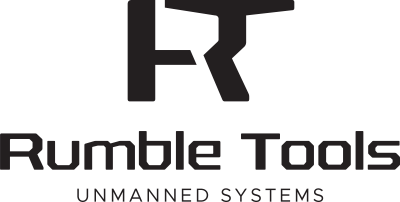


Electronic and digital aviation business cluster
The Electronic and Digital Aviation Business Cluster project explores and develops aviation towards the evolving and diversified air traffic culture of the future. Reaching these objectives calls for a solid background in fundamental aviation knowledge.
The Project
Welcome – learn more about the project!
Unmanned and manned aviation are rapidly converging – in the skies and at airports. Drone cargo transport is merging with land logistics, creating not only challenges but, above all, innovative opportunities for research and development. While low emissions are among aviation’s key future targets, the cornerstone of tomorrow’s air traffic will always be safety.
The Electronic and Digital Aviation Business Cluster project is a joint initiative by South-Eastern Finland University of Applied Sciences (Xamk) and Cursor Oy, the Kotka–Hamina Regional Development Company. Xamk leads the project, with Johanna Kunttu (Cursor Oy) and Marko Sorsa (Xamk) as project managers.
In the long run, the project contributes to shifting air traffic away from travel and transport systems that depend on non-renewable and polluting natural resources.

Key Project Activities
The project helps reduce climate-related risks by increasing awareness of the negative impacts of carbon-based logistics and by building confidence that more sustainable alternatives are within reach. It encourages ecological innovations and renewable energy solutions for both aircraft and airport operations, supporting long-term sustainability goals.
The Electronic and Digital Aviation Business Cluster project paves the way for new business opportunities in small cargo and passenger transport. By integrating new technologies into airport ground services and promoting sustainable energy solutions, the project strengthens the foundations for a greener and more resilient economy.
Air Traffic Studies Produced by the Project
The project has produced two studies related to air traffic. The first of them – Sustainable energy solutions for a small airport as part of a business modelexamined energy solutions for a small airport – carried out by Ramboll Oy under the leadership of Markku Nordström, a leading energy expert. The second study – Rapid accessibility network to Finland – focused on the prerequisites for rapid accessibility of air traffic in Finland. The study was carried out by Destia Oy, led by Riku Huhta, Project Manager for Strategic Transport Systems. The studies were part of the project work package of Cursor Oy, the project’s sub-implementer. Xamk participated in the implementation of the studies as the main implementer of the project. The studies were coordinated by the project’s project managers Johanna Kunttu and Marko Sorsa. The studies are available and can be read from the links below.
Read studies below (in Finnish only):
Project Measures and Activities
The Electronic and Digital Aviation Business Cluster has often been at the forefront of new challenges. The project has engaged in active dialogue with importers, stakeholders, and authorities. While aviation traditionally develops slowly, global changes – such as Russia’s war in Ukraine – required the project to adapt, for example by shifting long-distance international drone cargo test flights into domestic trials.
The project also prepares for alternative ways of operating drone cargo transport. It has supported and contributed to bringing a high-capacity cargo drone to Finland, enabling new opportunities for testing and development.
ADS-B/UAT air traffic positioning system
As one of its activities, the Electronic and Digital Aviation Business Cluster project examines digital solutions for small airports. Digital operations can help aerodromes adapt and remain viable amid the transformation of air traffic. In recent years, small airports have faced the challenge of steadily declining traffic, leaving different regions of Finland in unequal positions. A functional flight route network and airport infrastructure are vital for accessibility and, in turn, for local business operations.
In the future, airports must become more flexible and efficient in the services they provide. Electrifying aviation will form the foundation for short cross-regional routes, while drones will enable increasingly scalable logistics. All this must be integrated without compromising safety. From this perspective, the project has been involved in planning and establishing two ADS-B/UAT aircraft positioning systems at aerodromes in Eastern Finland.
Finland’s first ADS-B/UAT station was installed and commissioned in June 2024 at Helsinki-East Aerodrome in Pyhtää. The equipment, placed on the roof of the aerodrome’s aircraft hangar, was delivered by the Polish company Avionix Engineering. Immediately after installation, the Electronic and Digital Aviation Business Cluster project carried out test flights with a DJI Air 3 drone under the guidance of Ralf Heckhausen from Avionix Engineering. The system was proven functional: the DJI drone equipped with an ADS-B OUT transponder transmitted both drone and remote pilot location data through the system to other airspace users. However, visibility requires that the aircraft carries an ADS-B IN receiver connected to a suitable display device, such as a tablet or navigation system.
A second ADS-B/UAT station was installed in June 2025 at Mikkeli Airport. Together with the Pyhtää station, the Mikkeli system provides location and air traffic information particularly for aircraft flying above a certain altitude. With authorization from airport manager Sami Kahilakoski, the station was installed on the control tower. The equipment was found not to interfere with other air navigation systems. Again, project manager Marko Sorsa from the Electronic and Digital Aviation Business Cluster project conducted functional test flights with a DJI Air 3 drone. Mikkeli Airport holds EASA airport status, which means it operates under stricter requirements compared to smaller aerodromes. For this reason, the ADS-B/UAT station in Mikkeli is an important asset in studying and supporting the development of rapidly diversifying future air traffic. In addition to Xamk, VTT Technical Research Centre of Finland has also established an ADS-B station in Oulu for research and development purposes.
The ADS-B positioning system enables coordination between manned and unmanned aviation in shared airspace and supports the development of U-Space integrated airspace.
The installation of the ADS-B/UAT station in Mikkeli also gained attention, for example in communications by the City of Mikkeli. Read Tanja Rihu’s article via this link (in Finnish only):
New technology drives aviation forward – progress comes through action, not just plans.”
(Sami Kahilakoski, Airport Manager, Mikkeli Airport)
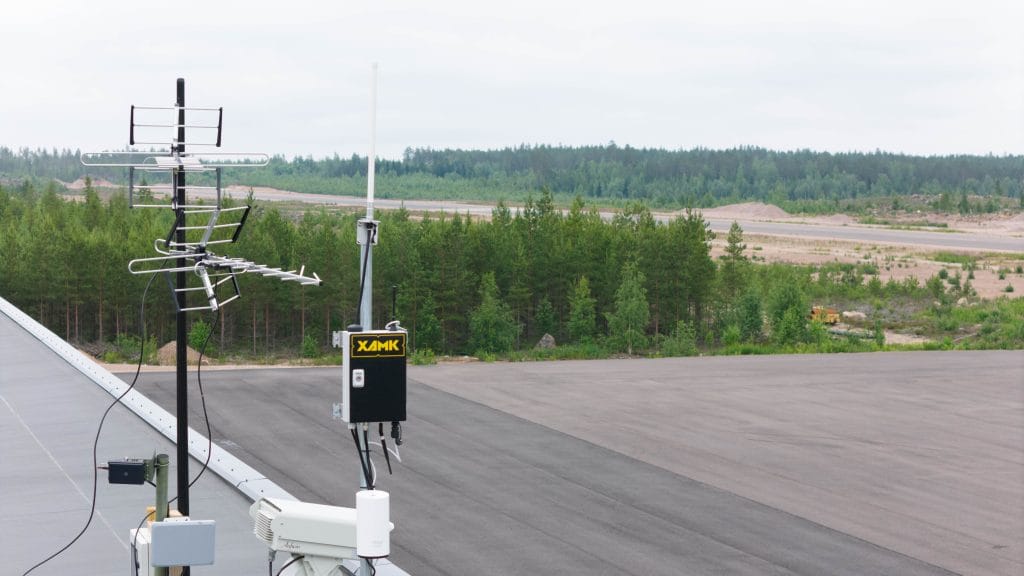
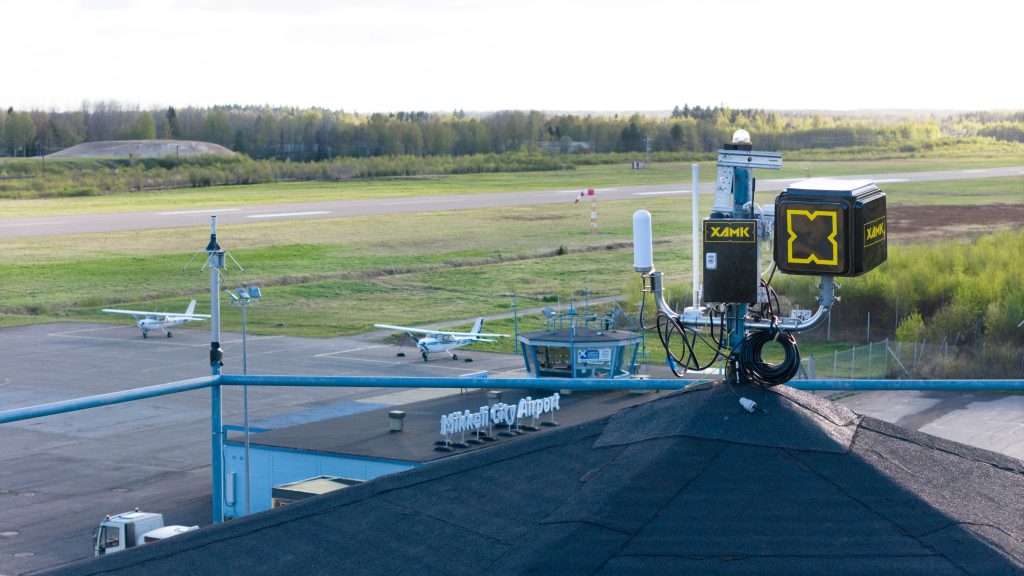
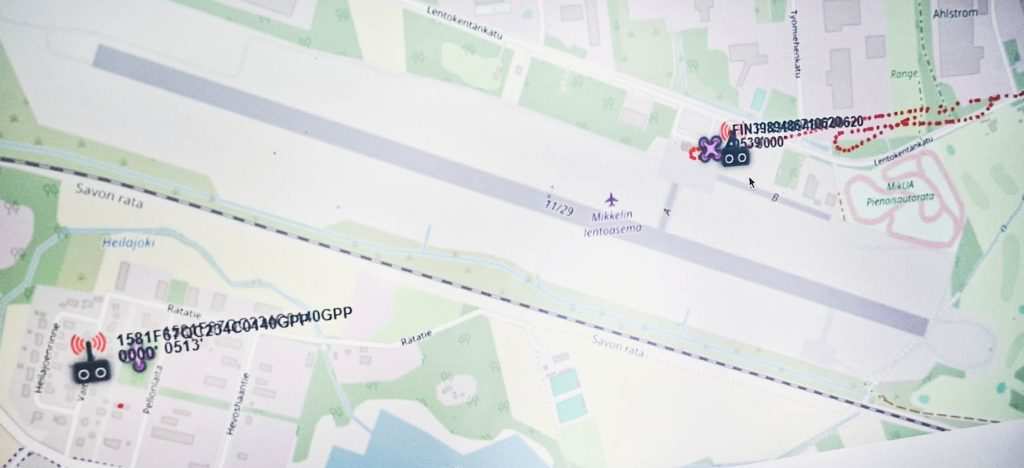
Long-range drone cargo flights
The Electronic and Digital Aviation Business Cluster project is carrying out long-range drone test flights over land and sea areas in the Kotka–Hamina region. The project tendered the flights as a full-service package, which was won by ALD Trade Oy from Espoo, operating under the trade name Vertical Hobby. The company, founded in 2006 and led by Antti Lipasti, who is also responsible for the technical implementation of the flights in this project, imports and sells drone systems and components, as well as other remote-controlled and robotic devices. For the project’s test flights, ALD Trade has brought to Finland the T-Drones VA25 VTOL aircraft. With a one-kilogram payload, it has an endurance of over three hours. The drone reaches a top speed of over 100 km/h, with a maximum take-off weight of 13.5 kilograms. For the project’s flights, battery capacity is reduced to allow more useful payload to be carried.
The long-range drone cargo flights will be carried out once the SORA authorization process required for operations in the specific category is complete. In 2025, Traficom’s SORA process took approximately seven months.
The project’s partner for long-range drone cargo test flights is HUB logistics Oy. The primary objective of the flights is to study how a telecommunications company’s spare part logistics can be organized via drone transport. The payload consists of telecommunications system components, transported from HUB logistics’ Kotka logistics unit to a maintenance and repair service provider in the Hamina. The flight route runs mainly over the sea. Safety is the primary consideration for the test flights – on the ground, at sea, and in the air. For this reason, the flights are conducted at times of day when most non-participating people are absent from the flight area or inside their workplaces. HUB logistics’ contact person and planner for the project activity is Development Director Anssi Tura.
In addition to actual cargo flights, the project aims to explore alternative navigation and control solutions, such as those based on inertial and image-based navigation. These flights will be carried out after the cargo test flights and will only take place over sea areas off Kotka–Hamina.
The project’s planned cargo test flights between Kotka and Estonia were cancelled due to the challenging and deteriorated security situation in the Gulf of Finland.
You can learn more about HUB logistics’ business and background here:
Test flights put safety first – on land, at sea, and in the air.
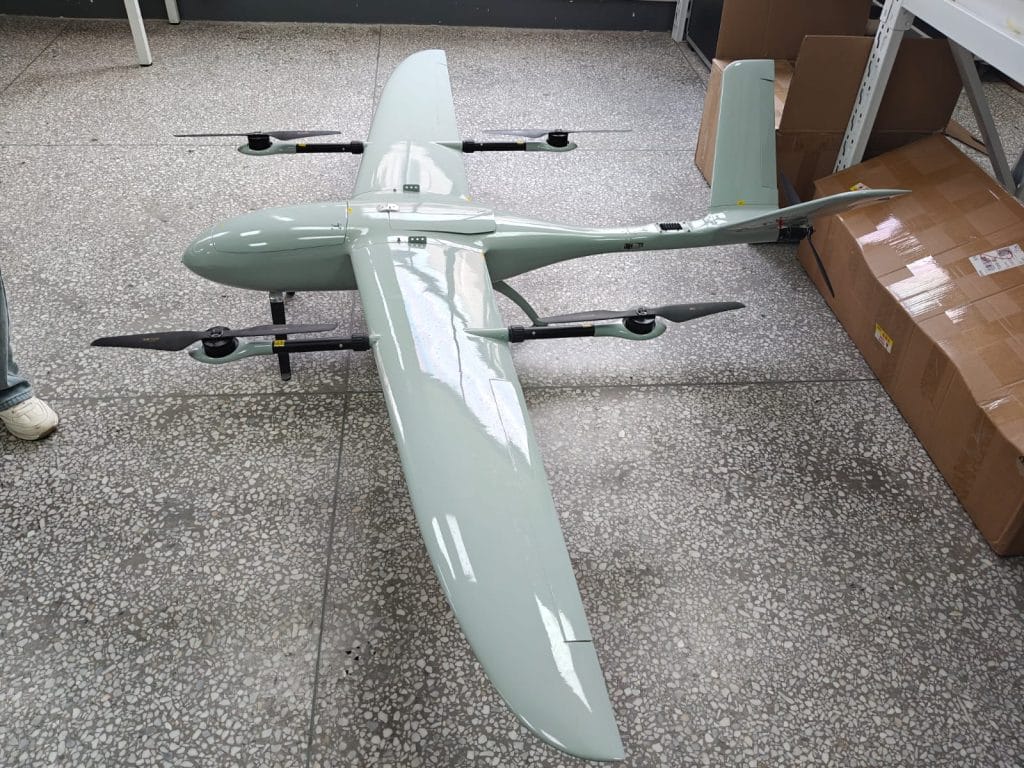
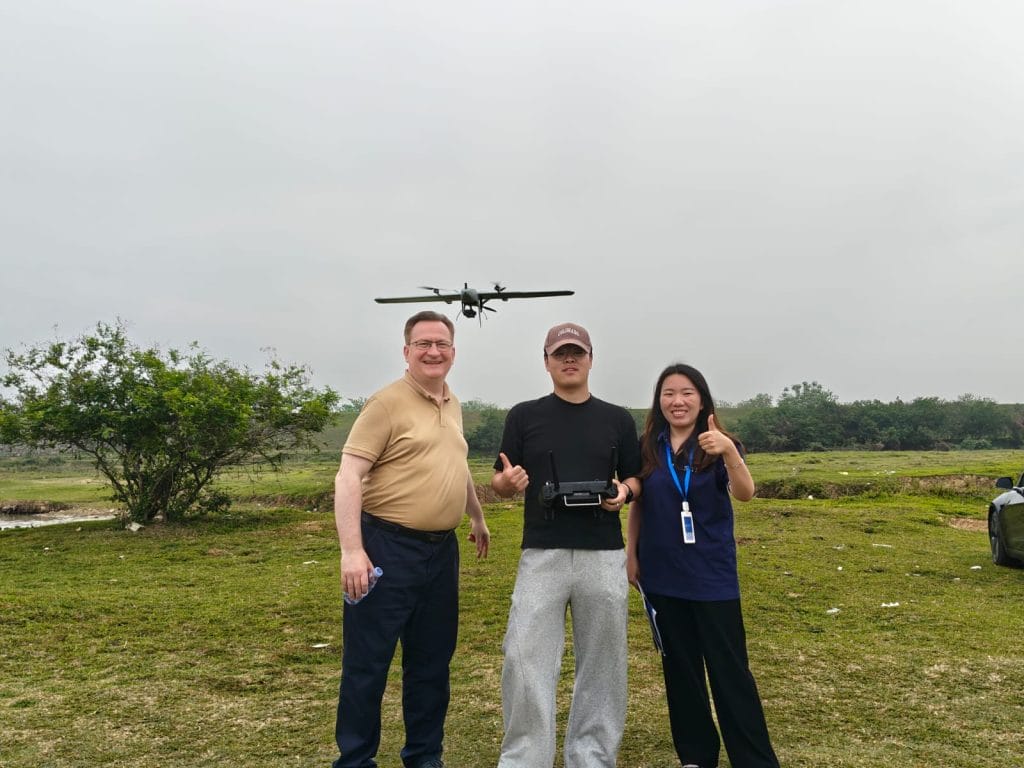
DJI FlyCart 30 -kuljetusdrone
Xamk has been among the first in Europe – and the very first in Finland – to acquire the large DJI FlyCart 30 drone, launched in spring 2024. The FlyCart has been developed for transporting various deliveries, especially to locations that are otherwise difficult, expensive, or even impossible to reach. The Electronic and Digital Aviation Business Cluster project uses the FlyCart for cargo transport test flights and for practical testing of the ADS-B aircraft positioning system.
The FlyCart 30 is equipped with either a 70-liter cargo box or a cable winch. The 20-meter winch cable enables lowering cargo to places where delivery would otherwise be challenging, very costly, or impossible. The FlyCart can also be used for vertical lifting tasks, for example in the maintenance and repair of wind turbines or various buildings.
Due to its large size and weight, the drone has required approval from Traficom for aviation use from its very first test flight. The aim of the Electronic and Digital Aviation Business Cluster project is to start flights with the DJI FlyCart 30 during 2025, once the ongoing regulatory approval processes are successfully completed.
Watch the DJI FlyCart 30 presentation video:
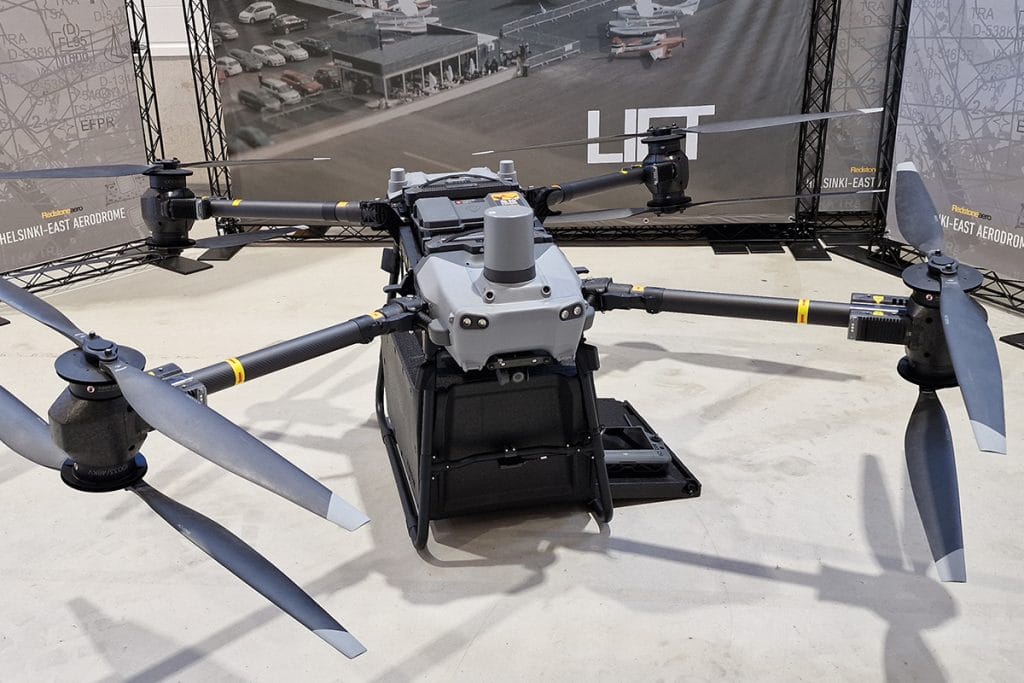
Electronic and digital aviation business cluster
Info
Budget
Project partners
Social media
More information
Project Manager Marko Sorsa (Xamk)
marko.sorsa@xamk.fi
+358 40 575 7661
Project Manager Johanna Kunttu (Cursor Oy)
johanna.kunttu@cursor.fi
+358 40 190 2569






